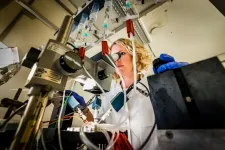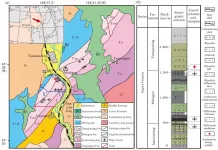3D images and artificial intelligence are combined to diagnose degrees of Parkinson's
2021-06-08
(Press-News.org) A new tool developed by the University of Cordoba, in collaboration with the Nuclear Medicine Unit at the Hospital Reina Sofía, could allow healthcare personnel to diagnose different degrees of Parkinson's, a disease that, according to World Health Organization (WHO) data, affects 7 million people worldwide.
To date, according to AYRNA group researcher Javier Barbero, "most diagnoses only determine whether or not the patient suffers from this disease." The research team has developed a system that makes it possible to specify the phase it is in, distinguishing between four different ones, based on severity.
Specifically, this new methodology combines Artificial Intelligence and the use of three-dimensional images of the area of the brain in which the neuronal degeneration is occurring. To do this, the research team has analysed, voxel by voxel (the equivalent of a 3D pixel), more than 500 photographs of the brains of people with symptoms compatible with the disease. The result is a mathematical algorithm that, after having processed all this information, is capable of estimating, once the image of the patient's brain has been scanned, the severity of the disease, based on neuron damage.
"The new tool produces this estimate automatically, providing an initial diagnosis that, of course, then has to be confirmed by the medical staff, with the images in front of them," explained Pedro Antonio Gutiérrez, another of the study's authors, together with César Hervás, Antonio Durán and Julio Camacho.
The researcher explained that the algorithm is capable of determining "which scanned areas of the brain are the most important and, therefore, those on which specialized personnel should focus their attention to confirm the diagnosis". But, why are some areas more important than others?
The answer: dopamine
Parkinson's Disease triggers a loss of density in the proteins responsible for transporting dopamine, aneurotransmitter essential to the control of movement. These 3D images are capable of detecting the density of these proteins and ascertaining the places in the brain where they are found, which offers clues to the severity of the disease.
Thus, the project "does not seek to substitute the assessments of specialized personnel, but rather to offer support for medical decision-making", said César Hervás, the AYRNA group's principal investigator. In any case, determining more precisely the phase this condition is in could help to adjust the amount of medication necessary, thus leading to better treatments for a chronic disease for which there is still no cure, though its prognosis has notably improved thanks to advances in neurology and the development of new drugs.
The process has also been validated through two different methodologies, both published in scientific journals. The first of them uses classic ordinal classification techniques, while the second is based on "Convolutional Neural Networks" (CNN), a type of Artificial Intelligence model that is very effective with vision-related tasks such as image classification.
INFORMATION:
ELSE PRESS RELEASES FROM THIS DATE:
2021-06-08
New molecules, developed by researchers at Linköping University, have promising properties as possible drugs against epilepsy. A study published in the journal Epilepsia shows that several of the molecules have antiseizure effects.
In people with epilepsy, the nerve cells in the brain become overactive, causing epileptic seizures.
"More than 60 million people in the world have epilepsy. A third of them still experience seizures despite taking medication, so there is a pressing need for new types of drugs", says Nina Ottosson, principal research engineer in the Department of Biomedical and Clinical Sciences, Linköping ...
2021-06-08
A new robot - named WomBot - that can be used to explore and study wombat burrows is presented in a study published in the journal SN Applied Sciences.
Wombats reside and sleep in burrows and occupy a different burrow every four to ten days. Parasitic mites that cause sarcoptic mange, a serious disease affecting wombats, are thought to be transmitted when wombats occupy each other's burrows but it has not been clear whether conditions within burrows promote this transmission.
Researchers from La Trobe University and the University of Tasmania, Australia developed WomBot in order ...
2021-06-08
For the first time, a unique study conducted at Lund University in Sweden has tracked the meteorite flux to Earth over the past 500 million years. Contrary to current theories, researchers have determined that major collisions in the asteroid belt have not generally affected the number of impacts with Earth to any great extent.
Researchers have been studying geological series since the 19th century in order to reconstruct how flora, fauna and the climate have changed over millions of years. Until now, however, almost nothing has been known about ancient meteorite flux - which makes sense since impact is rare, and the battered celestial bodies quickly break down as they encounter Earth's oxygen. A new study published in PNAS shows how researchers in Lund ...
2021-06-08
New insight on the link between a gene called SORBS2 and congenital heart disease has been published today in eLife, with findings that may help explain the cause of the disease in some patients.
Some people with congenital heart disease are missing part of the long arm of chromosome 4, otherwise known as chromosome 4q. Chromosomes are thread-like structures made up of DNA. When part of the chromosome is missing, it means that some of the genes located on that section are also lost. Previous studies have linked heart defects related to chromosome 4q deletion syndrome ...
2021-06-08
Converting Central American tropical forests into agricultural land is changing the colour and composition of natural material washing into nearby rivers, making it less likely to decompose before it reaches the ocean, a new Southampton-led study has shown.
The flow of dissolved organic material, such as soil, from land to the oceans plays an important role in the global carbon and nutrient cycles. Changing how land is used can alter the type and amount of material being transported, with widespread implications for ecosystems.
In this latest study, an international research team set out to learn more about the effects of deforestation on the coastal environment by studying material that flowed into rivers from various settings in a Central American rainforest, tracking its progress into ...
2021-06-08
applying a thin sheath around the defective vein eliminated the varicose vein problem in over 95 per cent of cases. The research team published their findings in the Journal of International Medical Research on 6 April 2021.
When the blood pools in the leg
Varicose veins are more than just a cosmetic problem: the unsightly bulges might result in serious health problems such as leg ulcers, thromboses or even pulmonary embolisms. The cause of varicose vein disease is usually a weakness in the connective tissue, which causes the vein wall to give way and thus the vein diameter to grow. This process is accelerated by pregnancy or frequent standing and sitting.
The increase in vein diameter impairs the function of the vein valves. The valve leaflets are pulled apart and a leak ...
2021-06-08
Weakened electrical signals in the brain may be an early warning sign of age-related neurodegenerative diseases such as Alzheimer's disease, suggests a study published today in eLife.
The findings hint at new ways to identify early on patients who may have an age-related brain disease. They also provide new insights on the changes that occur in the brain as these diseases develop.
"As tools for detecting Alzheimer's disease early are limited, there is a need to develop a reliable, non-invasive test that would enable early diagnosis," says first author Murty Dinavahi, who was a PhD Research Scholar at the Centre for Neuroscience, Indian ...
2021-06-08
The Late Triassic Tianqiaoling flora is well-known in China, and its discovery has changed our understanding of Chinese Late Triassic phytogeographical divisions. More broadly, this flora has great significance for the study of phytogeography in East Asia during this time. However, the previous dating of this flora was only evidenced by plant fossils and stratigraphic correlation, and the accurate dating has still not been achieved. Recently, the team of Dr. Yuhui FENG of Shenyang Normal University collected isotope dating samples from the bottom of the Tianqiaoling Formation, which is conformally contacted the Tianqiaoling flora-bearing beds (Figure 1). The ...
2021-06-08
Difficulty sleeping, sleep apnea and narcolepsy are among a range of sleep disorders that thousands of Danes suffer from. Furthermore, it is estimated that sleep apnea is undiagnosed in as many as 200,000 Danes.
In a new study, researchers from the University of Copenhagen's Department of Computer Science have collaborated with the Danish Center for Sleep Medicine at the danish hospital Rigshospitalet to develop an artificial intelligence algorithm that can improve diagnoses, treatments, and our overall understanding of sleep disorders.
"The algorithm is extraordinarily precise. We completed various tests in which its performance rivaled that of the best doctors ...
2021-06-08
When sailing along on the seas and you suddenly spot a porpoise's fin in the distance, chances are that you have only encountered a single animal. Porpoises are most often seen alone, but new research now suggests that they also roam in groups - and even enter into a sophisticated collaboration when hunting.
The way they collaborate surprises us, because the common perception among biologists is that porpoises roam and hunt alone, says Associate Professor Magnus Wahlberg, who is an expert in marine mammals and heads the Marine Biological Research Centre at the University of Southern Denmark (SDU).
Drone footage has revealed group hunting among porpoises coming together to hunt schools of fish.
The research team has recorded almost 44 hours of drone footage from the waters around ...
LAST 30 PRESS RELEASES:
[Press-News.org] 3D images and artificial intelligence are combined to diagnose degrees of Parkinson's

